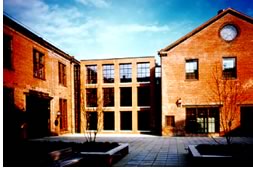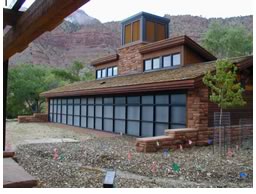
An interview with 2001 Thomas Jefferson Award winner Terrel Emmons, FAIA

 Q.
Was there an epiphany of some sort, or a project you worked on early in
your career, whereupon you realized that sustainable design was the way
to go?
Q.
Was there an epiphany of some sort, or a project you worked on early in
your career, whereupon you realized that sustainable design was the way
to go?
A. The most significant event was probably reading some of the writings
by Amory Lovins of the Rocky
Mountain Institute, and then hearing him in person back in 1994. Amory's
position, which he defended extremely well, was that sustainable design
did not necessarily have to cost more up front if the concepts of "integrated
design" were employed during the design process. The Navy at the
time was very interested in becoming more environmentally responsible
in its facilities programs, but the commitment of significant additional
funds that would increase the cost of construction was not something that
was likely to happen.
Q. Does the Department
of the Navy's adoption of sustainable design principles in its buildings
extend to retrofitting existing buildings or is it just for new construction?
A. The concepts of sustainable design apply equally to new construction
and to renovation and the reuse of existing buildings. In fact, reusing
existing buildings is itself a sustainable action. There are some strategies
that are difficult to employ, however. This difficulty could be based
on cost considerations or aesthetic reasons, especially in the case of
historic structures, where disturbing aspects of the building's exterior
may not be a permitted option.
Q. The sustainable
design program you installed at the Navy provided critical evidence of
the ability of a federal agency to construct high-quality, energy-efficient
buildings without increasing upfront costs-and helped inspire President
Clinton to mandate the use of sustainable designs at all federal agencies
via his issuance of Executive Order (EO) 13123, "Greening the Government
Through Efficient Energy Management" on June 3, 1999. Is there a
chance that this mandate for green design will be reversed or undone by
the current or future presidential administrations?
A. Executive orders are not law, but they do express the desires of the
President with respect to how his branch of the government is to carry
out its mission. EO 13123 was very significant in that it pointed the
entire government in a specific direction. Some agencies were already
moving in that direction, but many others were lagging significantly behind.
The EO has moved sustainability to the forefront for many agencies. We
were excited to see the President recognize the leadership of the Navy
and a few other agencies. Once it is realized that a significant number
of sustainability features can be incorporated into buildings without
necessarily increasing first cost, with the result being reduced energy
use and a wide range of other positive environmental initiatives, it becomes
the smart way to design. These are concepts that can easily be supported
by any administration.
Q. How do you measure
the effectiveness, on an agency-wide basis, of the use of sustainable
design principles? Is this best done by quantifying the energy saved?
The money saved? Is the latter easily quantifiable without resorting to
building life-cycle costs, which are sometimes viewed with skepticism?
A. There must be a comprehensive and objective means for measuring how
well we incorporate sustainability concepts into our buildings. Fortunately,
the LEED (Leadership in Energy and Environmental Design) Green Building
Rating System, as developed by the U.S. Green Building Council, has emerged
as the de facto standard, especially within the government. We can benchmark
the degree to which we are making our buildings "green," measure
progress as we get better at this, and most importantly as owners identify
standards that we expect the A/E community to attain or exceed in their
designs.
Clearly, energy measurement can be the most scientific, and the resulting savings are most easily understood. Documenting improved productivity of building occupants as a result of improved interior environments is more difficult. Similarly, measuring the life-cycle impacts on ecosystems as a result of the mining or harvesting of raw materials and their conversion into building products is difficult, especially when making comparisons between competing products. However, if we look at nothing but energy savings, the argument for sustainable design is overwhelming. Then the other benefits can be viewed as getting a "free ride," and the debate on their validity becomes unnecessary.
Q. Why has sustainable
design traditionally been a hard sell to the public? Is it the perception
that it's a costlier way to construct a building? And is that a correct
perception?
A. Up until the mid-90s, those few buildings that incorporated
sustainability features generally cost more to build. So the knock on
sustainable design followed naturally. When the Navy looked for examples
of where Amory Lovins' theories had been carried out, we found a few,
but no program on the scale of the Navy's annual construction program,
and certainly no program that dealt with a wide range of common, everyday
facilities. The three-year Pilot Project Program that we carried out between
1995 and 1997, wherein we consistently demonstrated that a substantial
number of sustainability features could be incorporated into buildings
regardless of their size, location, or function, as measured against the
LEED criteria, took on special significance. It proved to other federal
agencies that this could be done and led directly to the development of
EO 13123.
Q. What can you tell me about the costs
of constructing a building using sustainable principles versus constructing
buildings in the traditional way? Typically, how soon can building owners
expect to recoup the additional upfront costs?
A. If the concepts of "integrated design" are employed, one
does not need to spend more to obtain a "green" building. As
a result of our Pilot Project Program, we became so convinced of this,
the policies I wrote in early 1998 made it mandatory that every project
in the Navy (hundreds a year with total program cost in the billions)
would incorporate sustainability concepts with no increase in first cost.
While it varied from project to project, the minimum expectation was "Bronze
Level" under the LEED criteria, with selected projects attaining
the "Silver" or "Gold Level." Therefore "recouping
costs" became a nonissue.
Q. How did the partial
adoption of design-build at the Navy affect your ability
to use sustainable design and keep expenses associated with sustainable
design construction in the tolerable range?
A. As I indicated when I addressed the Design-Build Institute of America
national convention in 1999, design-build contracting currently offers
some special opportunities to maximize the extent to which sustainability
features are incorporated into a building. While the A/E community has
made great progress in the last couple of years in its understanding and
application of sustainable design, the construction side of the house
lags considerably behind. When a designer had really "pushed the
envelope" in their design, our experience was that most contractors
were unfamiliar enough with some of the new materials and systems that
their bids came in higher than projected. As a result, some of the best
designers were becoming somewhat conservative in their technology proposals
to avoid bid busts.
In design-build, where team members are working together throughout the project, the costs associated with various technology alternatives are better understood. With a ceiling established on project cost, thereby causing all proposals to be within budget, and with little likelihood of significant change orders, a sort of competition is created between the final few bidders as to which one can deliver the best project within the established budget. Where sustainability features have clearly been identified as a major aspect of how projects will be evaluated, proposals have often exceeded expectations in this regard. Design-build also allows one-of-a-kind products to be used by the government, since requirements are generally performance based in lieu of a prescriptive project specification where multiple manufacturers of a given product would be a government requirement. All of this is not to say design-build is always the best approach; there are other considerations. But the approach does have special advantages from a sustainability standpoint.
 Q.
Is there one project that stands out in your mind as one that you're most
proud of?
Q.
Is there one project that stands out in your mind as one that you're most
proud of?
A. Building 33, the headquarters building of the Naval Facilities Engineering
Command, my former agency, was one of the original pilot projects, and
the very first one in the Navy where a sustainability charrette was conducted
to redirect where design throughout the Navy (and ultimately the federal
government) would go. While there were limitations on the extent of sustainability
features that could be incorporated, due to the project being a National
Register historical property in a historic district, as our own headquarters
facility, it clearly conveyed our ideals and aspirations.
 Q.
You've had success building consensus for the use of sustainable design
in federal facilities. Is it more or less difficult to get the ball really
rolling toward acceptance of sustainable design in the private sector?
If it's more difficult, what will it take for the private sector to accept
sustainable design on a more widespread basis?
Q.
You've had success building consensus for the use of sustainable design
in federal facilities. Is it more or less difficult to get the ball really
rolling toward acceptance of sustainable design in the private sector?
If it's more difficult, what will it take for the private sector to accept
sustainable design on a more widespread basis?
A. When the Navy put out its sustainable design policies in June 1998—the
first federal government agency to do so—Environmental
Building News, reporting on the event, called it "one of the
most significant developments in green building in recent years"
and went on to note that, "This could be a very significant shot-in-the-arm
for green building and a strong incentive for mainstream A/E firms to
take green design seriously." With other federal agencies joining
our ranks over the next couple of years, culminating in EO 13123, we did
get the attention of the construction community. Ten percent of all construction
in the United States is funded by federal agencies. State and local governments
often follow the federal government's lead, so the overall impact is significant.
With the private sector—the other two-thirds of construction in the
U.S.—too often owners are not demanding that their designers utilize
sustainable design principles in their design. Therefore, the real burden
is on the A/E community, and specifically the AIA, to move the entire
profession to where it needs to be in this regard.
Q. You moved on about
a year ago to the National Park Service. Did you feel you had done everything
that you needed to at the Navy and had bigger fish to fry?
A. One thing we did right in the Navy, from the beginning, was to build
grassroots support for sustainable design. Early on, we held three- and
four-day workshops in our field offices—where the real work is done—to:
(1) educate our people using many of the top experts in the country, and
(2) allow our field personnel to generate the ideas and proposals for
where we should go as an agency. I could never have sat in Washington
and dictated that we make such a major course correction, no matter how
correct that decision might have been. Therefore, the Navy's leadership
in sustainable design has not resided at the top of the pyramid, but has
been a shared responsibility throughout the agency. Consequently, once
we had institutionalized sustainable design in the Navy through the 1998
policies, my departure in late 1999 hardly caused a ripple.
The National Park Service offers many unique leadership opportunities for an architect. At the head of the list is sustainable design. It is certainly the only agency whose purpose for existing essentially incorporates the tenets of sustainability—preserve and protect the natural, cultural, and historic resources of our country. My responsibilities in the Park Service are much broader than just sustainably designed facilities, so it has been a natural progression.
 Q.
What are your biggest priorities for implementing sustainable design at
the Park Service?
Q.
What are your biggest priorities for implementing sustainable design at
the Park Service?
A. I am especially excited about the educational opportunities within
the Park Service. We have over 300 million visitors each year to our national
parks, and it is often a captive audience interested in learning about
our great country. What a perfect opportunity to communicate sustainability
issues. In the past, visitor centers or other similar facilities were
created to house exhibits. We are now evolving to where, for a selected
number of parks throughout the country, the building and site development
itself will be an exhibit that demonstrates the use of materials, systems,
and design features that demonstrate sustainability as it relates to the
local and regional ecosystems.
One such facility, the Zion National Park Visitor Center, just opened this past year. Not only does the building itself incorporate state-of-the-art sustainability features, but also the entire park builds on this theme, as demonstrated by the propane-powered bus system that has replaced the choking, clogged roads in the park. An educational program prominently featured in brochures, and accompanying markers throughout the visitor center and site, educates visitors as to each sustainability feature and its greater impact on our environment. Similar projects are under design elsewhere. Could an architect ask for more?
Copyright 2001 The American Institute of Architects. All rights reserved.
![]()
|
|
|
